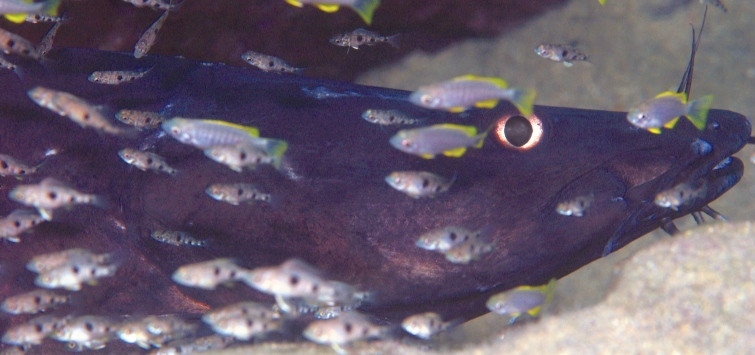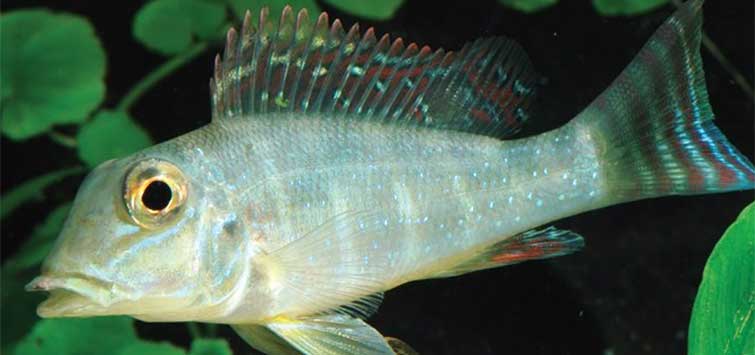Catfish-Cichlid Interactions in Lake Malawi
Author: Ad Konings
A look at the surprisingly complex interrelationships between a large catfish species and various cichlids in Lake Malawi.
Bagrus meridionalis Basics
Bagrus meridionalis, a large catfish endemic to Lake Malawi, is locally known as kampango, and it is highly prized for its taste. Most Malawians not only savor the kampango’s fatty meat but also appreciate its gut (with contents). The average size of an adult B. meridionalislies at about 70 cm (30 inches) for adult females and at about 50 cm (20 inches) for adult males, but specimens over a meter long and weighing more than 5 kg (11 pounds) are not at all rare. The maximum length of this common catfish is reported to be about 150 cm (5 feet), and although this size was attributed to males (Eccles, 1992) it is more likely that only females can attain such a length. Needless to say, a predator of this size needs a special aquarium, or it should be left to the care of public aquaria. Notwithstanding its large size and generally dark coloration, the kampango is a highly interesting fish and is involved in various interactions with the lake’s cichlids.
Bagrus meridionalis is a predator that hunts at night and may be the number one decimator of the smaller cichlids in Lake Malawi. Besides cichlids it also feeds on insect larvae and macro invertebrates such as crabs. During daytime the kampango hides in caves or rests in very deep water and is normally only seen during dives when they are breeding. Although it has been found in all types of habitats in the lake—from shallow rocky areas to very deep muddy bottoms—it appears to be associated with rocky outcrops, and it is in such areas that most are caught for consumption. The fishermen at Mbenji Island have specialized in collecting kampango, and normally tens of thousands of smoked catfish are stacked up along the island’s shore awaiting transport to the mainland. The island is surrounded by miles of rocky reefs, and these seem to be the prime habitat for the catfish.
Nesting Catfish
As mentioned before, B. meridionalis is normally only seen when breeding. The kampango is a substrate brooder, and both the male and female guard the nest and offspring. Most nests are situated at the rock-sand interface and most have a sandy bottom. It is only at rocky reefs and islands where there is no sand in the upper 50 m that B. meridionalis breeds in the pure rocky habitat, but this does not mean they are rarer in such environments. In fact, Chinyamwezi Islet, a rocky pinnacle in the southeastern arm of the lake, usually harbors more than a dozen breeding pairs in the upper 20 m.
Throughout the lake, most nests are beneath a large rock on a sandy bottom. I have never seen a kampango dig a nest, and it is likely that they adopt abandoned bowers of Oreochromis, locally known as chambo. These bowers are large, with a diameter of usually more than 1½ m (5 feet), and sometimes more than 60 cm (2 feet) deep. It is also not uncommon to find a pair of kampango in a large pit on the open sand, and the deeper you dive, the more common such open substrate nests become.
Breeding Season
The breeding season appears to be concentrated between the months of November and March, but breeding kampango can be found throughout the year. A successful pair can guard their young for several months so that it is more likely to encounter a couple with large young throughout the year. Pairs with eggs and tiny larvae are more common in November and December. A ripe female, noticeably the larger sex, is recognized by a swollen abdomen filled with eggs. More than 50,000 eggs have been found in such females, but nests with more than a couple hundred larvae or wrigglers are rare. On a few occasions I have seen the plaques of eggs—rather small eggs (1 mm) for such a large fish—and I estimated that 1000 to 2000 were deposited on the rocks of the nest. The eggs are translucent to milky-white and difficult to notice.
Mbuna Meals
Already in early life, B. meridionalis is beleaguered by cichlids, and during the early stages of the breeding period it is the mbuna Pseudotropheus crabro that has access to these eggs. Pseudotropheus crabro is always found associated with the kampango, and when the catfish is not breeding they are being “cleaned” by this bumblebee-colored mbuna. Probably because of its coloration and association with its cleaning behavior, P. crabro is allowed access inside the kampango’s cave and picks lice and other parasites from the catfish’s skin. This gives the catfish a positive association with the mbuna and will not attack the cichlid when approached. However, during the breeding period, P. crabro is not only an innocent varmint-killer but also relishes catfish eggs.
Eggs
While in the catfish nest P. crabro can quickly change color (losing the yellow bars resulting in a drab brown fish) and dart beneath the guarding hosts, picking away at the eggs. When noticed by either catfish parent it is vehemently chased from the nest, but since it has changed color the catfish doesn’t see the association of cleaner and egg-eater. I believe most of the eggs are eaten in this way and only a few hundred are left to hatch.
The pitch-black wrigglers are kept in a small depression either in the center of the pit or hidden in a crack in the rocks. I have never seen P. crabro hunting anything else than eggs, but the larvae and week-old juveniles are hunted by another bumblebee-colored mbuna, Melanochromis baliodigma. This mbuna doesn’t seem to eat the catfish’s eggs, but once you see a cave with M. baliodigma hanging around, you can be sure that inside there is a pair of kampango guarding small fry. The Melanochromis dives quickly in the nest and snatches a mouthful of larvae from beneath the parents.
Fry
After two to three weeks the catfish fry are too large to be hunted by mbuna, and it is at this stage that there are about 50 to 100 juveniles left. So, from the estimated 1000 to 2000 eggs, only a very small percentage survives the onslaught by relatively small mbuna.
Cichlid Prey
Not until the catfishes are near adult size do they again fall prey to cichlids. At that stage it is the skin-ripping Docimodus evelynae that wreaks havoc among the catfish population by cutting sizeable “slabs” of skin from the catfish each time they bump into one. They usually operate in deep water because that is where one can encounter kampango during daytime. I have only once witnessed a series of attacks by two D. evelynae on a few catfish, but the rather sluggish catfish hardly get a chance to avoid the lightning-fast attacks of the predatory cichlid. As a result, most adult kampango show scars—usually the white flesh beneath the skin is visible—as a souvenir of such attacks.
Bizarre Breeding Behaviors
Back to the breeding B. meridionalis, as there are many more interesting observations to be made. The kampango is the only fish known where the offspring is raised by feeding them with non-fertilized eggs that are regularly shed by the female. Instead of leading the offspring around to let them feed, those young stay for about three months at exactly the same position which, of course, poses the problem of how to feed them. The immediate area surrounding the nest does not contain enough food for the young, and although the male regularly scoops up substrate from nearby and sifts it through his gills to feed the young with invertebrates contained therein, stomach analyses of the small catfish young revealed that more than 90 percent of its contents consisted of eggs.
Eggs for Breakfast
It was discovered (McKaye, 1986) that the female sheds large numbers of non-fertilized eggs which are immediately eaten by the growing young. In fact, they hang around the female’s vent in order to catch the eggs that from time to time come streaming out of the female. Amazing as this may be, I wouldn’t be surprised if one day P. crabro or M. baliodigma find out about this new source of protein and then compete with the catfish young for this bounty.
Guarding the Nest
Both parents guard the nest, but it is the smaller male who is the strongest guarder and remains the closest to the juveniles. The male is also the only one who collects mouthfuls of sandy substrate and, back in the nest, expels it through his gills. The juveniles are therefore often found either directly under the male’s gills or under the female’s vent.
The size of the kampango, compared to that of the surrounding other fishes, is huge and is a testament to the resourcefulness of cichlids to profit from the protective powers of a catfish pair defending its offspring. Almost always one can locate breeding kampango by the cloud of tiny cichlids hovering over the catfish’s nest. Down in the deepest part of the nest are the wrigglers or tiny catfish fry that are protected by both male and female hovering right above them. Some cichlid species found out that when their young are released over the catfish nest they are in the sphere of protection of the large catfish who are not interested in such small prey. In fact the catfish also profits from this situation because if there are predators around trying to hunt their young, the predators are more likely to snatch some of the peripheral juvenile cichlids in the cloud above the nest before they can penetrate to the bottom of it. For the cichlids it provides additional protection to their term offspring.
Cichlid Offspring
Most cichlid species in Lake Malawi don’t provide care to their offspring once they are ready to leave the female’s mouth. Juveniles of sand-dwelling cichlids, just released by their mother, huddle together and are in search of similar-sized cichlids to join their ranks. Large concentrations of fish give protection to the individual, in particular the ones in the center of the school. Since some species seem to always release their offspring near catfish nests, even when no other cichlid juveniles are around, they kind of seed the school of juveniles (from many different species) that hover over these nests.
Mylochromis melanonotus is one of those seeding species. Interestingly M. melanonotus is a predator of kampango young, which it snatches from beneath the hovering parents, and is thus well-acquainted with the situation around catfish nests. Another species that is often seen releasing juveniles at the nest is Ctenopharynx pictus. All juveniles released are too big to fit inside their mother’s mouth and can thus no longer be cared for. The young cichlids hovering over the nest feed on plankton and occasionally on substrate-living organisms when they get stirred up from the bottom by the catfish. I have also seen tiny cichlids pick from the catfish’s skin as if they were feeding off secretions or off small parasites on the skin.
Further Complexities
The schools of cichlid juveniles hovering over kampango nests are such a common fixture in the fauna of Lake Malawi that some species have adapted to such gatherings as well. The predatory cichlid Sciaenochromis fryeri is specialized in feeding on the juvenile cichlids hovering over kampango nests. While almost all predators fear the large catfish and never come within striking range, S. fryeri knows from experience that as long as you leave the catfish young alone, the large kampango is not going to attack you. It is thus not rare to see several S. fryeri lined up around the periphery of the hovering cloud of cichlid juveniles, making regular inroads into the school, snatching off one juvenile at the time. In fact, ornamental fish collectors wait for the kampango breeding season to catch S. fryeri, as it is then that this normally secretive species can be found in numbers.
At a single nest at any given time during breeding season you can watch a pair of B. meridionalis guard their offspring, see cichlid females release their charges into the cloud of juveniles hovering over the nest, and witness specialized predators like S. fryeri and juvenile Exochochromis anagenys pick off those juveniles. A kampango nest is the focus of many cichlids, but it is also that of many a diver who will spend his or her entire air supply watching it.
Enjoy your cichlids (and your catfish too)!

.png?h=595&iar=0&w=2781&hash=5FD5E69473BCC22199FBFA2FB71B6033)



